| |
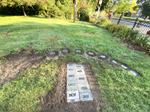 |
Northville |
Michigan |
USA |
Analemmatic |
Dial 1148 |
| This is a human (analemmatic) sundial built into a grassy landscape. At the center is the Zodiac Walkway with stone slabs labeled with the months of the year, arranged in two vertical columns from January through December. A plaque indicates the user to stand on this central walkway according to the month of the year. An ellipse of hour marks surround the walkway from 8am to 7pm. When someone stands at the center line adjacent to the month, their shadow falls across the current time of day. The hours are set for daylight saving time and corrected longitude by 34 minutes to the Eastern Time Zone, thus showing approximately 1:34 at the north point of the hour mark ellipse. |
| |
| |
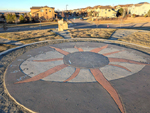 |
Erie |
Colorado |
USA |
Analemmatic |
Dial 1147 |
| Analemmatic human sundial, marked with both standard and daylight saving hours (5am-9pm MDT) arranged on an ellipse determined by the latitude.. The whole sundial is 10 ft (3m) in diameter, surrounded by a gravel moat. The zodiac walkway is encompassed in a circular center sun, with months marked in blue. Vertical sandstone stones at the edge mark the cardinal directions. |
| |
| |
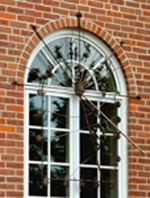 |
Simsbury |
Connecticut |
|
Vertical Dial |
Dial 1146 |
| Called the Millennium Sundial, this vertical dial is made of wire rods and from a distance is nearly invisible. It declines S-SW and has small hour disks in Roman numerals from 7am to 6pm. The dial also has wire solstice boundaries. This starts to sound like a poorly designed dial, but in fact is a very fine dial, casting its shadow of time onto the floor of the staircase landing on the inside of the window. As reported in the NASS journal, The Compendium, "The design of the sundial incorporates figures representing different aspects of the life and history of the School. The top half of the dial contains seven sets of figures in a field of sun rays emanating from the center of the sundial. At the top are two maypole dancers dancing around the vertical sun ray. They represent the long tradition of the School in celebrating spring with dancing on Dogswood Day – a day of games established by the founder of the School, Ethel Walker." |
| |
| |
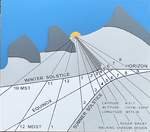 |
Canmore |
Alberta |
Canada |
Vertical Dial |
Dial 1145 |
| This 2.13m x 2.13m (7ft x 7ft) vertical sundial is constructed of aluminum with a powder coat presenting a motif of the Three Sisters Mountains (Îyârhe Nakoda, the traditional language of the First Nations Stoney Nakoda, also refers to the peaks as the Three Sisters). The dial declines S 55 deg to the West, resulting in late morning hours and compressed afternoon hours. The hour lines are longitude corrected for Mountain Time and marked with Standard (10am-8pm) and Saving Time (12pm-9pm) . The solid gnomon is a simple triangle 20cm (8 in) high and 52cm (20 in) long on the base, with the style tilted 21.1 deg away from the dial face. |
| |
| |
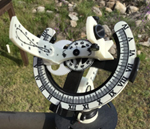 |
Vernon |
British Columbia |
Canada |
Heliochronometer |
Dial 1144 |
| This heliochronometer, called a Gard Clock Hybrid Sundial, is a precision instrument constructed by 3D printing. The dial featured in the photos below has a large equatorial ring 7.7 inches (19.5cm) in diameter with an inner geared ring of 144 teeth. The teeth engage a planetary gear system to a secondary minute dial for accurate time reading. It also uses a curved analemma and nodus vertical plates. The nodus is an oculus with tilt adjustment, casting a ring and spot of light onto the rear analemma. Separate equatorial ring and analemma are made for the Northern and Southern hemispheres. The heliochronometer has longitude adjustment and with the analemma, converts local solar time into civil time. Measured accuracy is less than one minute of time. |
| |
| |
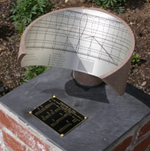 |
Anchorage |
Alaska |
USA |
Equatorial Dial |
Dial 1143 |
| A 10 inch (25cm) wide, cylindrical-segment equatorial dial approximately 8 inches (20cm) high, fabricated from a section of large PVC pipe. The dial face is aluminum sheet bonded to the PVC pipe and marked by photochemical engraving with hour lines showing analemmas to correct for EOT; hour lines are corrected for longitude and show both standard and daylight saving Arabic hour numerals. Winter and summer solstices and equinoxes are marked. Time and date are read by the tip of the gnomon needle in the center of the dial. |
| |
| |
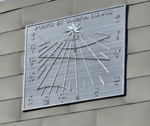 |
Liberty Township |
Ohio |
USA |
Vertical Dial |
Dial 1142 |
| A stainless steel, vertical south facing dial, declining 15 degrees to the west. The dial is approximately a 6.5 feet (2m) square. Hours are measured VII – XII – V in winter and 8 – 12 – 6 in the summer, telling time in increments of the half-hours. Equinox, summer and winter solstice lines are shown. The gnomon originates from a sun motif with a hole for nodus to indicate the season. |
| |
| |
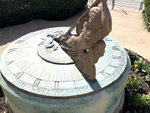 |
Cincinati |
Ohio |
USA |
Horizontal Dial |
Dial 1141 |
| This is a 5 foot (1.5m) diameter, bronze horizontal dial sitting on a limestone plinth. The dial tells time from V – XII – VII in 15 minute increments. Underneath the style of the gnomon in relief is a sculpture of Hygieia, goddess of health, cleanliness and hygiene. She is emerging from a snake that wraps around the dial face, representing the medical profession. |
| |
| |
 |
Cincinati |
Ohio |
USA |
Alignment |
Dial 1140 |
| The alignment ring of seven sculptures indicates the time of solar noon and date of the solstices and equinoxes. The sculpture is titled “Seven Vessels Ascending/Descending”. The alignment of the seven sculptures is on a 40 feet (12m) circle of grass surrounded by a circular red brick plaza.. In the very center of the circles is a 2-foot (.6m) diameter marble slab indicating the direction of sunrise/sunset on the solstices and equinoxes. It also indicates the N-S meridian line and time of solar noon on the solstices. |
| |
| |
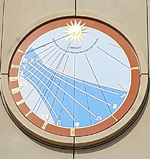 |
Cedar Rapids |
Iowa |
USA |
Vertical Dial |
Dial 1139 |
| A beautiful 6-ft (2m) circular vertical dial, declining to the south-east. At the circle's circumference are hour numbers from 5am to 1pm. Background is white and within the solstice boarders, painted azure blue, showing the time limits from 4:30am to1:30pm. The gnomon is a thin wire rod with a spherical nodus. The dial has white declination lines for the months, marked with the signs of the zodiac. |
| |
| |
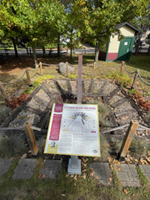 |
Labelle |
Quebec |
Canada |
Horizontal Dial |
Dial 1138 |
| The dial is a square 1.7m x 1.7m structure in the ground using railroad ties as the perimeter and as the hour lines from 6am to 6pm. Hours are marked in Roman numerals. The style of the gnomon is made out of a portion of a railroad track, supported by odds and ends of railroad ironwork. |
| |
| |
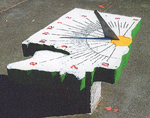 |
Everett |
Washington |
USA |
Horizontal Dial |
Dial 1137 |
| A concrete dial in the shape of the state of Washington, about 30 x 50 in (76 x 127 cm). Radiating from the stainless-steel gnomon are 48 hour lines, providing time lines every quarter hour from 6am to 6pm. Hours are Arabic numbers at the end of hour lines that vary in length throughout the state. Galvanized and painted black are markers for the cities of Vancouver, Olympia, Tacoma, Seattle, Everett, Bellingham, and Spokane. The dial sits on a concrete pillar 23 in (59 cm) tall. |
| |
| |
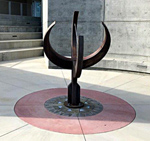 |
Mission Viejo |
California |
USA |
Equatorial Dial |
Dial 1136 |
| This steel equatorial dial is about 4-foot (1.2m) in diameter with the equatorial and meridian arcs in the shape of thin crescent moons. The 10-minute time marks are appropriately offset for the dial's longitude about 2.3 degrees (9 minutes) east of the pacific time zone meridian. The offset is marked with "Local Solar Noon".. Arabic numbers mark the hours from 6am to 6pm. The dial stands on a steel pillar with a compass rose at the foot. The whole dial is in a concrete circular plaza.. The dial and pillar all suffer rust. |
| |
| |
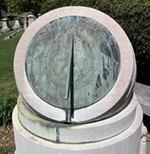 |
Louisville |
Kentucky |
USA |
Vertical Dial |
Dial 1135 |
| This south-facing reclining dial has a weathered brass plate 13-inches (33cm) in diameter sitting on a cut face of a sculptured sphere approximately 21-inches (53cm) in diameter. The dial consists a series of rings: (1) at center is an eight-pointed compass rose and a decorative outer border of small tulip-like figures.(2) next is the abbreviations for the 12 months of the year with tick marks each day and marked every 10 days. Outward is the notation "Clock Faster than the Sun" and "Clock Slower than the Sun" for the four changes across the months. Outward still is a ring showing the equation of time in increments of 5 minutes. (3) the outer ring is a chapter ring of time, delineated to the minute with a standard tick mark style with short quarter hour lines, longer half hour, and longer still for hour lines. Roman numerals show the hours from 6am to 6pm. |
| |
| |
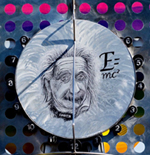 |
Oak Ridge |
Tennessee |
USA |
Vertical Dial |
Dial 1134 |
| This vertical dial is set on an 11-foot (3.4m) stand very near the front wall of the Museum. The 18-inch (46cm) dial face is eye-catching with a portrait of Albert Einstein hand engraved into stainless steel. The Equation of Time curve is used symbolically as a wave of light that in dual nature becomes a particle to create the photoelectric effect. This is not a functioning sundial even though the gnomon is set to its latitude in Oak Ridge. Created as a south facing dial, it sits facing nearly due west. The hour numbers from 6am to 6pm were uniformly placed, "with the idea that they coordinate with the gnomon and axis of the earth." They do not represent the proper hour spacing for a vertical dial, being more appropriate for an equatorial sundial.. |
| |
| |
 |
Mars Hill |
North Carolina |
USA |
Armillary Sphere |
Dial 1133 |
| This simple stainless steel armillary is called the "TimeKeeper Sundial" is approximately 20 inches (51cm) in diameter with meridian circle and equatorial timekeeping circle. The gnomon is a classic arrow rod. The hexagon stainless steel pedestal has six medallions at the top with medial motifs. |
| |
| |
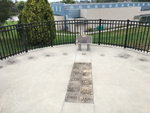 |
York |
Pennsylvania |
USA |
Analemmatic Dial |
Dial 1132 |
| This analemmatic sundial is in a circular plaza about 20 feet (6m) in diameter. The dial has Arabic numbers 6am to 6pm, centered on 12 noon with no longitude correction (only about 7 minutes of time). The zodiac walkway is unusual in that it reverses the left-right position of June and July, simulating the analemma figure 8 pattern. The adjoining plaque implies that by standing slightly left or right of the zodiac center line, you can adjust your shadow time to show civil time. |
| |
| |
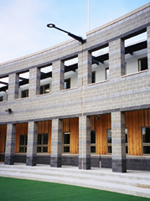 |
Hannover |
Pennsylvania |
USA |
Vertical Dial |
Dial 1131 |
| This is a "virtual" sundial of a horizontal pole near the roof line casting a shadow onto the curved wall in front of the school building.that faces due south. No hour lines or declination lines have been painted on the wall, but there is a shadow "map" indicating where the nodus shadow is throughout the year (see photo #3). As an educational tool, students can create their own map out the time, date and shadow tip on the curved wall. |
| |
| |
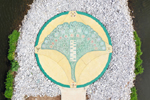 |
Springfield |
Missouri |
USA |
Analemmatic Dial |
Dial 1130 |
| Situated on a peninsula extending into Lake Drummund, this 25-foot (7.6m) double-ring analemmatic (human) sundial is easily seen on Google Earth. The mosaic dial shows both standard (6am-6pm) and daylight savings hours (7am-7pm). |
| |
| |
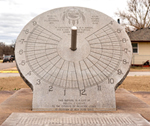 |
Medicine Lodge |
Kansas |
USA |
Equatorial Dial |
Dial 1129 |
| This is an Erickson Monumental Equatorial Sundial. The dial face is made of Elberton Blue Granite with a 3-inch (8 cm) Stainless Steel gnomon resting on a concrete base. The circular dial face is 6 feet (2m) in diameter and 6 inches (15cm) thick. The gnomon casts shadows during the spring and summer on the top face of the granite dial and reads time on the back side of the dial during fall and winter. The Equation of Time is engraved on two stone plaques 11-feet (3.4m) long and 6 feet (2m) wide . On the dial's summer side, the EoT curve shows the time correction from March 22 to Sep 21. On the winter side, the EoT curve is from Sept 22 to March 21. The Sundial was dedicated at the time of the 1985 Medicine Lodge Peace Treaty celebration. |
| |
| |
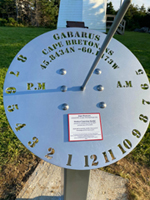 |
Gabarus |
Nova Scotia |
Canada |
Equatorial Dial |
Dial 1128 |
| An equatorial sundial of aluminum with stencil-punched hours from 5am to 8pm. No hour marks are used. The sundial works from March 21st until September 21st when the sun is above the celestial equator. The dial was commissioned for the 550th birthday of Nicholas Copernicus (Mikolaj Kopernik) and was developed by Cape Breton's Polish community in collaboration with the Gabarus Lightkeepers Society and the Cape Breton University Tompkins Institute. |
| |
| |
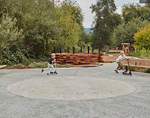 |
Felton |
California |
USA |
Analemmatic Dial |
Dial 1127 |
| This analemmatic sundial is set in a concrete circle about 12 feet (4m) in diameter. It has a plain zodiac walkway with month abbreviations. The hourly numbers are set in an ellipse appropriate for the 37 deg latitude. Unfortunately the dial is in shade during the early morning hours. |
| |
| |
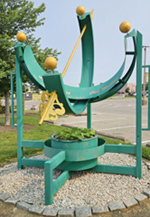 |
Fairfield |
Ohio |
USA |
Equatorial Dial |
Dial 1126 |
| This is a 10-foot (3m) equatorial sundial made of steel and painted green. Gold painted balls are located on the ends of the meridian and equatorial arcs. Following tradition, the gnomon is a rod with a decorative arrow and tail painted gold. The base includes a decorated plat holder with eight compass points and azimuth degrees marked in 10 degree increments and labeled every 30 deg. Both Roman numerals mark the hours from 6am to 6pm. Arabic numerals mark every third hour. The numerals and other details are vinyl graphics in gold and red. |
| |
| |
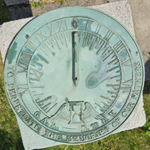 |
Wabash |
Indiana |
USA |
Horizontal Dial |
Dial 1125 |
| This horizontal bronze dial is approximately 12 inches (30cm) in diameter with a heavy green patina. The gnomon long ago was broken off. The inner chapter ring shows local solar time in half hour increments marked in Roman numerals from 6am to 6pm. The dial is decorated by an hour glass. The dial sets on a square 12x12 in (30x30cm) plinth. The pedestal is a column 4 in (10cm) in diameter and approximately 36in (91cm) tall with the top half fluted. |
| |
| |
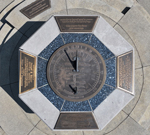 |
Fairfield |
Ohio |
USA |
Horizontal Dial |
Dial 1124 |
| A compound bronze horizontal dial approximately 24in (61cm) in diameter with a second meridian transit gnomon hole to cast a beam of light onto a noon analemma. The outer chapter ring shows Standard Time with Roman numerals, 1 hour marks. The inner chapter ring show Daylight Savings Time in Arabic numerals with 15 minute marks. Note that like most horizontal dials standard/daylight time is local solar time, measuring time as it crosses the meridian. The noon analemma uses holidays and seasons as date marks. The analemma is offset from the dial's N-S meridian, showing the sun's illumination on the analemma curve using local Daylight Savings Time. Fairfield Ohio, even at 84° W is on Eastern Time, such that to tell civil time, one needs to add 38 minutes to shadow time. If one looks at the plaque that contains a graph of the Equation of Time, that 38 minutes is included. Both the offset noon meridian dial and EoT graph result in precise civil time. The whole complex is an octagon about 5 ft (1.5m) across. |
| |
| |
 |
Newington |
Connecticut |
USA |
Analemmatic Dial |
Dial 1123 |
| This is an analemmatic sundial designed by a team of four eighth grade students in 2017. This was a project that incorporated four classes: Geometry, 8th Grade Science unit on Solar System, Aerospace Science unit on air navigation, and Engineering Design. The 8th grade class was split into six teams of about four students each in a competition for best design. The principal picked the winning design and the winning team with the sundial impressed him so much that their project was presented to the school superintendent. He was so impressed that he had a professional landscape company build the sundial. It took about a year to build, with the original student designers coming back for a ribbon cutting ceremony. The dial is made of ceramic tile with tiles engraved with the months in the zodiac walkway. |
| |
| |
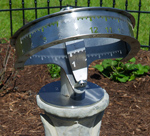 |
Sequim |
Washington |
USA |
Digital Dial |
Dial 1122 |
| This dial began as a Thewes Sundial with an equatorial arc with cut out hour numbers that illuminate a central plate. This original dial went missing in the 1970's.. But when the new stainless steel sundial with a 150mm radius equatorial arc was finished, it took the Thewes concept into the 21st Century. The equatorial arc not only has the hourly Arabic numbers, but has a row of finely cut marks every five minutes with very easily distinguishing shapes to see the hour, half, and quarter hour indicators. And rather than a central plate tilted to the site's latitude, this dial has a plate that rotates on the polar axis set at the center of the equatorial arc. |
| |
| |
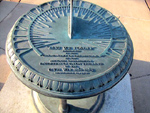 |
Springfield |
Illinois |
USA |
Horizontal Dial |
Dial 1121 |
| This is a classic Grand Army of the Republic (GAR) sundial. It is a bronze, horizontal sundial approximately 24 inches (61cm) in diameter, with an ornate design of ovals at the exterior, sloping down to 30 inches in diameter. Hours are marked from 5am to 7pm in Roman numerals. Time is marked in quarter hours. The gnomon is solid with a simple under-curve. The whole dial rests on four upright pillars which sit on a circular bronze base. This is one of a series of bronze sundials presented by Daughters of Union Veterans of the Civil War, dedicated to the memory of the Grand Army of the Republic. |
| |
| |
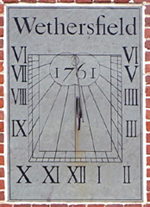 |
Wethersfield |
Connecticut |
USA |
Vertical Dial |
Dial 1120 |
| A rectangular vertical sundial, 31 x 45 inches (0.8x1.1m), made of Vermont slate. Engraved with Roman hours from 6am-6pm and hour lines with delineation in quarter hours. The lines and letter engravings are painted black. The gnomon is a brass rod, suspended slightly off the noon line with an elegant "S" brass support. The date engraved on the dial of "1761" is not the date of the dial, but rather the founding of the church itself. The building is on the National Register. George Washington attended services here in 1781 when he was in Wethersfield meeting with Rochambeau on war strategy. In the late 1990's the Church was restored, and in that process a later addition was demolished on the building's south side, exposing an open niche above the auxiliary doorway. A perfect place for a sundial, orientated slightly off due south. |
| |
| |
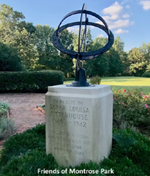 |
Georgetown |
District of Columbia |
USA |
Armillary Sphere |
Dial 1119 |
| This is a simple bronze armillary, known as the Rittenhouse Armillary, and is about 2 feet (0.6m) in diameter consisting of a meridian ring, equatorial ring, and zodiac ring aligned with the polar axis. The gnomon is a traditional arrow rod casting its shadow telling local solar time using Roman numerals. Friends of Montrose Park relate its history: In 1956 the Georgetown Garden Club erected a memorial to Sarah Louisa Rittenhouse, through whose “vision and perseverance this land became Montrose Park”. Rittenhouse had worked relentlessly to persuade Congress and the Senate to authorize purchase of the Montrose estate, which was up for sale...The Garden Club commissioned architect Gertrude Sawyer who designed a bronze armillary sphere set on top of a limestone pedestal. Alterations were made to the center of the Entrance Ellipse, originally designed by Horace Peaslee in 1919, in order to accommodate the memorial. This memorial was a gift from the Georgetown Garden Club and was dedicated in 1956. |
| |
| |
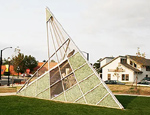 |
Casper |
Wyoming |
USA |
Horizontal Dial |
Dial 1118 |
| This monumental horizontal dial sculpture, "The Confluence of Space and Time", stands 30 feet (9m) tall with giant hour markers from 10am to 2pm. It features interactive features of a windmill in its interior and illumination by lights through the broken glass panels. The sundial is constructed of stainless steel, stainless steel Mesh, 6,800 lbs 3084 kg) of recycled glass, white marble rock, cast reinforced concrete. The designer/artist Matthew Dehaemer said of the project, "“Various graphically rendered spots surrounding the installation reveal the totality of our earth’s geological history and the existence of life since the beginning of our planet. This sundial sculpture utilizes the wind that is such a trademark of the area. Like the marks left by a variety of prehistoric animals, humans and other life forms throughout history, the wind has also helped carved the rock formations that make up the landscape of Wyoming today and into the future.” |
| |
| |
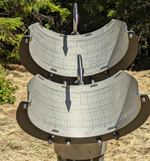 |
Manchester |
California |
USA |
Equatorial Dial |
Dial 1117 |
| This is a double equatorial sundial of stainless steel (slightly burnished to show the shadow without reflections). Each cylinder is approximately 16 inches (40cm) in diameter. with hour lines drawn as analemmas (June to Dec and Dec to June). The gnomon are two pointed steel rods, reading the time and date at the shadow tip. Declination lines are shown for each month, and if you can interpolate the monthly date lines, the sundial can be read to about 30 seconds accuracy. The double equatorial sundial sits on a mounting pole that at one time held a solar array. " The round pole allowed me to set azimuth and level easily, altitude from latitude with a digital plumb, then I then used the sundial adjustments to get the meridian offset and tweaked it all on the equinox using GPS time." |
| |
| |
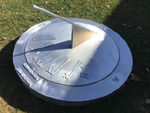 |
Waynesville |
North Carolina |
USA |
Horizontal Dial |
Dial 1116 |
| This is a large horizontal sundial 5-feet (1.5m) in diameter with a twist. The dial is made of aluminum and set on a circular concrete dais several inches above ground level. Hour lines of thin aluminum rods extend from 9am to 3pm using Roman numerals. The gnomon is a braced aluminum rod that creates a sleek, modern looking sundial. But the twist is the dial face can be slightly rotated to accommodate the equation of time (EoT). Above the solar noon pointer is a small scale for the rotation offset. |
| |
| |
 |
Houston |
Texas |
USA |
Horizontal Dial |
Dial 1115 |
| In the Sharp Family plot is a lovely statute titled Roses of Yesterday of a lady holding wilted roses in one arm and a sundial in the other. The dial itself is circular, approximately 12 inches (30.5cm) in diameter. The hour marks in a narrow chapter ring are Roman Vi to VI, divided into quarter hours. The original gnomon was set to the 6-6 line at the extreme south of the dial, but until circa 2019-2020 the gnomon had long been missing, Since then, a new gnomon has been installed but it is a disaster: It is set backwards, it is the wrong size, and cut at the wrong angle for Houston. It would be a service to the lovely statue and dial to remove the gnomon. |
| |
| |
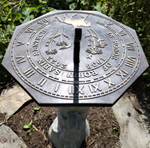 |
Great Falls |
Virginia |
USA |
Horizontal Dial |
Dial 1114 |
| This octagonal horizontal sundial measures 15 inches (380mm). It is made of bronze and given a brown patina with burnished letters, numbers and artwork. The dial has a chapter ring with Roman hours from V to VII delineated on the inner ring by half hours and the outer ring by quarter hours. It has a gnomon gap to accommodate the shadow of a 1/2 inch (12mm) wide gnomon. Artwork on both the dial face and gnomon was specifically drawn by Barbara Smith to honor Robin Sabin Rentsch with an equestrian motif and flowers grown at the Great Falls Library and tended by the Great Falls Garden Club. The dial sits on a pedestal in the form of a tree trunk with two squirrels racing upwards. The dial was 3D printed in plastic sections, assembled, and sent to Chicago Crucible, LLC where it was cast into bronze by Lloyd Mandelbaum. |
| |
| |
 |
Union City |
New Jersey |
USA |
Horizontal Dial |
Dial 1113 |
| This beautiful sundial is 4 feet (122cm) sundial and made from two layers of 1.25 inch (3.1cm) thick hardened marble. Arabic hour numbers from 6am to 6pm, letters, and gnomon are 1/4 inch (6.35mm) brushed gold anodized aluminum. The gnomon is shaped as a slanting "P" and to the south of the dial center, the name "Pellarin". The dial sits on a 3-foot (1m) black marble cube. |
| |
| |
 |
Clarksville |
Indiana |
USA |
Horizontal Dial |
Dial 1112 |
| This is a round,George marble sundial 48-inches (122cm) in diameter with a plain triangular gnomon. The chapter ring has Roman hours etched from 5am to 7pm, delineated in quarter hours. The dial sits 8-inches (20cm) above a 60-inch (152cm) wide concrete base. Official town records show that this dial was donated to the town of Clarksville to commemorate the country's Bicentennial in 1976. The inscription says the dial was dedicated to George Rogers Clark, the town’s founder and a Revolutionary War hero. He was the brother of William Clark of “Lewis & Clark Expedition” fame. |
| |
| |
 |
Ogunquit |
Maine |
USA |
Horizontal Dial |
Dial 1111 |
| This is an elegant commercially made bronze horizontal dial about 18-inch (.46 cm) in diameter. The Chapter Ring has hours from 5am to 7pm, divided in quarter hours. Hours are marked in Roman Numerals from VI to VI. A bird sits profile in the gnomon, filling the space beneath the style. The gnomon foot is accurately placed to a line between VI-VI, but the gnomon angle was not measured. The dial rests on a polished brown granite pillar. At the base of the pillar is a small bronze plaque. |
| |
| |
 |
Georgetown |
Ohio |
USA |
Horizontal Dial |
Dial 1110 |
| This is a large commercial bronze horizontal dial set at ground level on a circular concrete pad. The dial is embossed with Roman hours in a chapter ring and delineated for quarter hours. The inscription circles the dial in an outer rim. The gnomon is standard with a bird beneath the style. However the gnomon is set about 2 inches (5cm) north of the VI-VI line. It may not matter as the dial appears to be under a tree. |
| |
| |
 |
Hamilton |
Ohio |
USA |
Horizontal Dial |
Dial 1109 |
| This is one of a series of bronze sundials presented by Daughters of Union Veterans of the Civil War, dedicated to the memory of the Grand Army of the Republic. The dial is 24 inches in diameter, with an ornate design of ovals at the exterior, sloping down to 30 inches in diameter. Hours are marked from 5am to 7pm in Roman numerals with time marked in quarter hours. The dial base is open bronze work held by four pillars sitting on a circular bronze base. Through the efforts of Kathleen Stuckey Fox and the citizens of Hamilton, OH, the dial and surrounds of Monument Park have undergone significant restoration. Hawkins & Hawkins, LLC of Cincinnati expertly cleaned and refinished the Hamilton GAR dial. Since the original gnomon was missing, they also designed, cast, and welded into place a new bronze gnomon. |
| |
| |
 |
Rockville |
Maryland |
USA |
Reflective Equatorial |
Dial 1108 |
| One of Bill Gottesman's unique-design Renaissance dials of cast and structural bronze with a 27 inch diameter helix with a celestial-north aligned axis. Time is told by a focused beam of light that moves around the helix throughout the day. The light beam is reflected from a long cylindrical unsilvered mirror in a structure that supports the helix. A sliding time scale within the helix can be adjusted for EOT and DST and includes longitude correction. Once this scale is adjusted for date, the dial shows civil, or clock, time. The dial base is cast bronze allowing adjustment for latitude and placed on a concrete pedestal with a black granite plinth. |
| |
| |
 |
Early |
Texas |
USA |
Horizontal Dial |
Dial 1107 |
| This is a monumental sundial with a gnomon is 52 feet (16m) long and 24 feet (7.3m) tall at the point. Tall concrete pillars mark the hours from 7am to 5pm in an offset circle 60 feet (18m) in diameter. The 7:00am/5:00pm pillars are 7 feet (2.1m) tall, and stair-step in height 1 foot (0.3m) for each hour until the noon pillar at 12 feet (4m) tall. The pillars are asymmetrically arranged to accommodate the longitude offset from Central Standard Time at 90° longitude. The pillars are set at the outer edge of a 6 foot (2m) concrete walkway and back lit by LEDs at night. Directly under the tip of the gnomon are brass cardinal direction letters, memorial bricks and a rock garden, under which a time capsule has been buried to be opened on the city's 100th birthday. At night, LED lights in gnomon cut-outs show stars, the moon, and planets. There is a plaque in front of each pillar showing who made the donation for that particular pillar. Memorial bricks were another fundraiser. Around $107k in donations was raised in addition to grants from the city for the sundial project. |
| |
| |
 |
Ottawa |
Ontario |
Canada |
Vertical Dial |
Dial 1106 |
| A 1.2m (47 in) wide by 0.7m (28 in) high vertical sundial that declines 5 degrees to the west of south. Hour lines are longitude-corrected. The dial face was laser cut from a large 3mm (1/8 in) thick plate of steel and powder coated with white paint. The cut-out pieces of the steel sheet were beautifully assembled together and mounted near the front door of the house. A conic gnomon was selected to point to the hour lines from 9am to 6pm summer hours. |
| |
| |
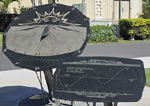 |
Laie |
Hawaii |
USA |
Vertical Dial |
Dial 1105 |
| To accommodate Hawaii's low latitude, this is a reclining sundial more than a meter (3 feet) in diameter and stands over 2 meters (6 feet) tall. It is carved from a dark, igneous stone with a bronze conical gnomon and set on bronze legs. The sundial includes a separate, stone-carved legend that includes an explanation of how to correct the gnomon shadow-time indicated on the dial for the time of year. The sundial, taken as a whole is reminiscent of a bird, enhanced by the conical gnomon and sun on the horizon given two eyes. At the edge of the dial are symbols of the zodiac |
| |
| |
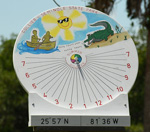 |
Naples |
Florida |
USA |
Equatorial Dial |
Dial 1104 |
| A whimsical equatorial dial set on a pole. The solid dial face has a drawing of canoeists opposite an alligator with its mouth open and.above them is a smiling sun wearing sunglasses. Time on the summer side is from 6:30am to 7:30pm while on the winter side, time is delineated from 7am to 7pm.(but still using daylight saving time). Both sides have mean solar time adjusted for longitude, about 24 minutes.. |
| |
| |
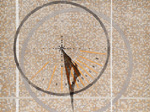 |
Salem |
Oregon |
USA |
Vertical Dial |
Dial 1103 |
| This vertical declining sundial is form with small squares of tile, showing the hours within a dark grey circle of tiles. The hours are marked by long orange-tile hour lines while the half-hours are marked by two dark grey tiles. A secondary circle of light grey adorns the wall, showing the length of the shadows and making the dial aesthetically pleasing. The background tiles are porcelain in common designer colors. The gnomon is a substantial stainless steel shape formed with a hole and curving points on the downward side, allowing leaves and small branches to slide off. |
| |
| |
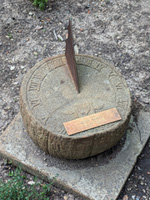 |
Westerville |
Ohio |
USA |
Horizontal Dial |
Dial 1102 |
| This horizontal dial is of weathered concrete, about 38cm (15 inches) in diameter. Roman numerals mark the hours from 5am to 7pm. A large bronze gnomon with foot in the center of the round dial casts the shadow. The north edge of the gnomon is shaped into a face. The garden includes a traditional knot garden, a water feature, and a unique sundial made of herbs. |
| |
| |
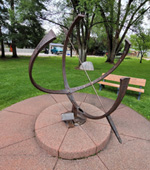 |
Carbondale |
Colorado |
USA |
Equatorial Dial |
Dial 1101 |
| This equatorial is of hammered wrought iron about 2m (6 ft) in diameter with fluted ends on both the equatorial and meridian arcs. Time is shown from 4am to 8pm with small brass hour marks engraved with Roman numerals. Time is offset for the longitude correction. Brass cardinal directions are set into the iron based |
| |
| |
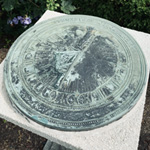 |
Halifax |
Nova Scotia |
Canada |
Horizontal Dial |
Dial 1100 |
| A bronze horizontal dial 36cm (14 in) in diameter with chapter ring of Roman numeral hours from V (am) to VII (pm). Hours are delineated in quarter hours and extend from 4am to 8pm (unmarked). Noon is designated by an "O". Gnomon has the inset profile of a bird. At south is father time with a scythe. The conglomerate pedestal is slowly disintegrating. |
| |
| |
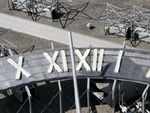 |
Vancouver |
British Columbia |
Canada |
Horizontal Dial |
Dial 1099 |
| This is intended to be a horizontal sundial, but positioned poorly and viewed by nearly no one.. The chapter ring is marked out in Roman numerals running from V (am) to IV (pm) on a large semi-circular arc of open metalwork supported by a trellis structure. It is very large, about 40 meters across. The gnomon is a separate structure and is not positioned or oriented correctly. |
| |